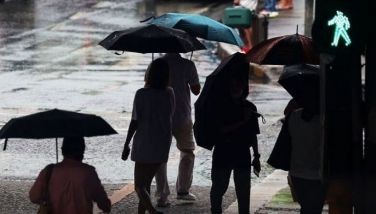Mayon evacuees refuse to return home due to threat of lahar flows
July 6, 2001 | 12:00am
LEGAZPI CITY — Fearing lahar flows the heavy downpour could unleash, evacuees refused to return to their communities despite volcanologists’ advice they could do so as Mayon Volcano’s seismic activities have died down.
Volcanologist Ed Laguerta and Cedric Daep, Albay’s public safety head, said they even hopped from one evacuation center to another to help municipal officials explain the actual situation to the evacuees.
Daep, however, clarified that they are not forcing the evacuees to go back to their communities, but are assuring them that they are safe if they live outside of the six-kilometer permanent danger zone.
The other day, the Philippine Institute of Volcanology and Seismology (Phivolcs) lowered the alert level around Mayon to four. Despite this, only about 1,462 families, or 6,874 people, have returned to their homes in Camalig town, according to the provincial social welfare office.
"We are not forcibly driving them out of the evacuation camps. We are merely informing them that it is now safe to go back to their own houses where they will be more comfortable than to further stay in the evacuation centers," Daep said in a radio interview.
Daep, meanwhile, said seven barangays here and five others in nearby Daraga town have to remain under evacuation because of the threat of lahar flows.
Daep based his warning on the latest lahar survey involving different river channels around Mayon, which spewed out millions of cubic meters of lahar since it erupted last June 24.
Defense Undersecretary Edgardo Batenga, accompanied by other top government officials, arrived here yesterday to check the conditions of evacuees and determine the extent of the damage Mayon’s eruption wreaked on agricultural crops.
Volcanologists warned yesterday that secondary explosions may occur on the slopes of Mayon. — Cet Dematera, Celso Amo and Felix de los Santos
Volcanologist Ed Laguerta and Cedric Daep, Albay’s public safety head, said they even hopped from one evacuation center to another to help municipal officials explain the actual situation to the evacuees.
Daep, however, clarified that they are not forcing the evacuees to go back to their communities, but are assuring them that they are safe if they live outside of the six-kilometer permanent danger zone.
The other day, the Philippine Institute of Volcanology and Seismology (Phivolcs) lowered the alert level around Mayon to four. Despite this, only about 1,462 families, or 6,874 people, have returned to their homes in Camalig town, according to the provincial social welfare office.
"We are not forcibly driving them out of the evacuation camps. We are merely informing them that it is now safe to go back to their own houses where they will be more comfortable than to further stay in the evacuation centers," Daep said in a radio interview.
Daep, meanwhile, said seven barangays here and five others in nearby Daraga town have to remain under evacuation because of the threat of lahar flows.
Daep based his warning on the latest lahar survey involving different river channels around Mayon, which spewed out millions of cubic meters of lahar since it erupted last June 24.
Defense Undersecretary Edgardo Batenga, accompanied by other top government officials, arrived here yesterday to check the conditions of evacuees and determine the extent of the damage Mayon’s eruption wreaked on agricultural crops.
Volcanologists warned yesterday that secondary explosions may occur on the slopes of Mayon. — Cet Dematera, Celso Amo and Felix de los Santos
BrandSpace Articles
<
>
- Latest
- Trending
Trending
Latest





























